Latest News
My latest ramblings.
Enjoy! I definitely got important things to say
My latest ramblings.
Enjoy! I definitely got important things to say
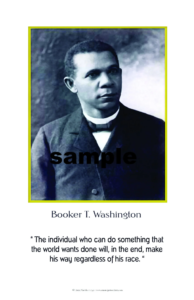
In the pantheon of American history, few figures embody the transformative power of education as profoundly as Booker Taliaferro Washington. Born into the brutal confines of slavery, Booker T.Washington would rise to become the preeminent African American educator and political leader of his time, founding the Tuskegee Institute and advocating for an educational philosophy that centered on practical skills, economic self-sufficiency, and character development.
His approach to liberation was nuanced, often controversial, and frequently misunderstood—a careful balancing act between accommodation and advancement in the violently segregated landscape of post-Reconstruction America.Washington’s educational philosophy represented a radical departure from traditional academic approaches.
He envisioned education not as mere intellectual cultivation but as a tool for tangible liberation—a means by which formerly enslaved people could achieve economic independence, personal dignity, and ultimately, social progress.
To fully appreciate Washington’s educational philosophy, one must understand the violent aftermath of Reconstruction and the systematic disenfranchisement of African Americans that characterized the late 19th century. The promise of emancipation had given way to the brutal reality of Jim Crow, with Black citizens throughout the South subjected to lynching, voter suppression, and economic exploitation.
Between 1890 and 1908, every Southern state would pass laws effectively eliminating Black voting through literacy tests, poll taxes, and grandfather clauses—precisely during the years when Washington was establishing his influence.
In this climate of racial terror and economic oppression, Washington developed an educational approach that emphasized economic self-determination as a pathway to eventual political and social equality. He witnessed firsthand how attempts at political organizing were met with violent suppression, leading him to advocate for a different strategy—one that would build Black economic power through education, land ownership, and business development.
Booker T. Washington entered the world as human property on April 5, 1856, on a tobacco plantation in Franklin County, Virginia. The exact date of his birth was unknown to him for much of his life—a common reality for those born into bondage, denied even the basic knowledge of their own existence.
In his autobiography, Up From Slavery, he recalled the dehumanizing conditions of his early years: “I cannot remember a single instance during my childhood or early boyhood when our entire family sat down to the table together, and God’s blessing was asked, and the family ate a meal in a civilized manner.”
Despite these brutal circumstances, Washington exhibited an early fascination with learning that would define his life’s path. He carried books for his master’s daughter to the schoolhouse, longing for the knowledge they contained. He later wrote: “The Negro worshipped books.
We wanted books, more books. The larger the books were the better we like[d] them. We thought the mere possession and the mere handling and the mere worship of books was going, in some inexplicable way, to make great and strong and useful men of our race.”
The end of the Civil War brought legal freedom but little material change for Washington and his family. He described the day of emancipation when a Union soldier read the proclamation: “After the reading we were told that we were all free, and could go when and where we pleased. My mother, who was standing by my side, leaned over and kissed her children, while tears of joy ran down her cheeks.
She explained to us what it all meant, that this was the day for which she had been so long praying.” Soon after, his family moved to West Virginia to join his stepfather, Washington Ferguson.It was in Malden, West Virginia, that the young Washington began his formal education while working in salt furnaces and coal mines. He recalled the challenge of learning while supporting his family: “I had to work from early until late, and had little time to devote to learning my lessons.
I found, however, that I could get time by rising early in the morning, and I used this plan for a good while.” His determination caught the attention of Viola Ruffner, the wife of the mine owner, who employed him as a house servant and encouraged his educational pursuits—an experience that taught him the value of hard work and discipline that would later inform his educational philosophy.
Washington’s educational journey took a decisive turn when he learned of the Hampton Normal and Agricultural Institute in Virginia—a school established to educate freedmen and their descendants. Despite having barely enough money for his journey, he traveled nearly 500 miles, mostly on foot, to reach the institution.
His entrance exam was telling: asked to clean a room, he meticulously cleaned it three times until it was spotless, demonstrating the dignity of labor that would become central to his philosophyAt Hampton, under the mentorship of General Samuel C. Armstrong, Washington encountered an educational model that combined academic instruction with practical training.
| Year | Event | Significance |
|---|---|---|
| 1856 | Born into slavery in Virginia | Beginning of life in bondage |
| 1865 | Emancipation after Civil War | Gained legal freedom |
| 1872 | Journey to Hampton Institute | Beginning of formal education |
| 1875 | Graduation from Hampton | Foundation for educational philosophy |
| 1878-79 | Study at Wayland Seminary | Exposure to alternative educational models |
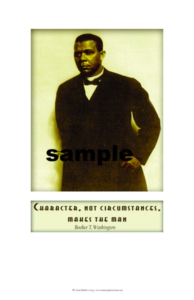
In 1881, at just 25 years of age, Washington was recommended by General Armstrong to lead a new normal school for African Americans in Tuskegee, Alabama. The Tuskegee Normal and Industrial Institute began with minimal resources—a shanty, a church, and a determined teacher with a vision.
Washington described the challenge: “I had no schoolhouse, no land, no lumber, no money. But I had faith in the future and in the people I had come to serve.”From these humble beginnings, Washington built an educational institution that embodied his philosophy of “learning by doing.” Students literally built the school with their own hands—making bricks, constructing buildings, growing crops, and raising livestock.
This approach was both practical and philosophical: it provided hands-on training while instilling the values of diligence, self-reliance, and pride in workmanship. Washington believed that economic independence was the foundation upon which social and political equality would eventually be built, stating, “No race can prosper till it learns that there is as much dignity in tilling a field as in writing a poem.”
The Tuskegee curriculum represented a radical integration of practical skills with academic content. Students spent half their day in academic classes—reading, writing, history, and mathematics—and the other half learning trades such as carpentry, masonry, agriculture, and domestic work.
This approach was designed to make the school self-sufficient while providing students with marketable skills they could bring back to their communities.Washington’s educational philosophy extended beyond technical training to encompass character development and civic responsibility. He wrote: “We wanted to teach them how to bathe; how to care for their teeth and clothing.
We wanted to teach them what to eat, and how to eat it properly, and how to care for their rooms. Aside from this, we wanted to give them such a practical knowledge of some one industry, together with the spirit of industry, thrift, and economy, that they would be sure of knowing how to make a living after they had left us.” Education was holistic—addressing the mind, body, and spirit in equal measure.
Under Washington’s leadership, Tuskegee grew from a single teacher and thirty students to a thriving institution with over 100 buildings, 1,500 students, 200 faculty members, and an endowment of approximately $2 million (equivalent to over $43 million today).
The institution became a model for industrial education across the South and attracted prominent visitors, including President William McKinley and his cabinet.Perhaps Tuskegee’s most significant impact was its ripple effect throughout Black communities. Graduates fanned out across the South, establishing schools and teaching the practical skills they had learned.
George Washington Carver, who headed the agricultural department, developed innovative farming techniques that helped struggling Black farmers improve their yields and economic stability. The school became a beacon of hope and demonstration of Black capability at a time when many whites argued that African Americans were incapable of intellectual or technical achievement.
| Year | Students | Faculty | Buildings | Endowment |
|---|---|---|---|---|
| 1881 | 30 | 1 | 1 (rented) | Minimal |
| 1890 | 400 | 28 | 20 | $100,000 |
| 1900 | 1,100 | 103 | 67 | $1,000,000 |
| 1915 | 1,500 | 200 | 100+ | $2,000,000 |
At the core of Washington’s educational philosophy was the concept that manual labor possessed inherent dignity and value. This perspective emerged from his own experiences at Hampton Institute and reflected his belief that economic self-sufficiency was the necessary foundation for broader social advancement.
He criticized the tendency among some recently freed slaves to view education as an escape from physical work: “There was among the people a feeling that to secure an education meant to have a good, easy time, free from all necessity of manual labour.”Washington’s emphasis on practical skills was not, as some critics claimed, a rejection of intellectual development but rather an integration of theory and practice.
He argued: “The longer I live and the more experience I have of the world, the more I am convinced that, after all, the one thing that is most worth living for—and dying for, if need be—is the opportunity of making someone else more happy.”
For Washington, the primary purpose of education was not merely intellectual or technical training but character development. He believed that building strong moral character was essential for African Americans to gain the respect of white society and advance collectively.
In his famous Sunday evening talks to Tuskegee students, he emphasized virtues such as cleanliness, thrift, punctuality, and integrity—what he called “the fundamentals of civilization”.
This focus on character was encapsulated in his statement: “Character, not circumstance, makes the person”. He viewed education as a moral enterprise that should produce not just skilled workers but ethical citizens who would contribute to the uplift of their communities.
Washington’s educational philosophy extended beyond individual advancement to encompass collective racial progress. He envisioned Tuskegee as a training ground for community leaders who would return to their homes and teach others the practical skills and values they had learned.
This “each one, teach one” approach created a multiplier effect that amplified Tuskegee’s impact far beyond its campus.His concept of racial advancement was fundamentally cooperative rather than confrontational. He believed that by demonstrating economic value and moral character, African Americans could gradually overcome prejudice and secure their rights.
This approach was summarized in his famous advice: “Cast down your bucket where you are” —urging Black Southerners to invest in their communities rather than seek opportunities elsewhere, while simultaneously encouraging white Southerners to recognize the value of Black labor and entrepreneurship.
On September 18, 1895, Washington delivered what would become known as the Atlanta Compromise speech at the Cotton States and International Exposition. Addressing a racially mixed audience in the heart of the Deep South, he outlined a vision of race relations that would dominate African American political thought for the next two decades.
His message was both revolutionary and conciliatory: he urged African Americans to “cast down your bucket where you are” and seek advancement through industrial education and economic accumulation rather than political agitation. The most famous passage encapsulated his strategic accommodationism: “In all things that are purely social we can be as separate as the fingers, yet one as the hand in all things essential to mutual progress”.
This statement effectively endorsed segregation in social matters while calling for cooperation in economic development—a position that would draw fierce criticism from other Black leaders but that Washington viewed as a pragmatic strategy for gaining white support while building Black economic power.
The Atlanta address immediately drew criticism from more radical Black intellectuals, most notably W.E.B. Du Bois, who accused Washington of trading political and civil rights for economic opportunities. Du Bois and others formed the Niagara Movement (which would later become the NAACP) specifically to challenge Washington’s accommodationist approach.
They argued that without political power and civil rights, economic gains would always be vulnerable to white suppression.Washington defended his approach as strategic pragmatism rather than surrender. Behind the scenes, he secretly funded legal challenges to segregation and voting restrictions while publicly maintaining his conciliatory stance.
He believed that overt political challenges would trigger violent backlash, while economic advancement would eventually force white society to recognize Black capabilities and grant rights voluntarily. As he stated: “The opportunity to earn a dollar in a factory just now is worth infinitely more than the opportunity to spend a dollar in an opera-house” —a practical recognition of immediate economic needs over symbolic gestures of equality.
Washington’s influence extended beyond education to the highest levels of national politics. He became an unofficial advisor to Presidents Theodore Roosevelt and William Howard Taft on racial matters and Southern appointments—a role that earned him the nickname “The Wizard of Tuskegee”.
His White House dinner with Roosevelt in 1901 generated intense controversy, with Southern newspapers condemning it as a breach of racial etiquette.Through his Tuskegee Machine—a network of newspapers, organizations, and loyal supporters—Washington wielded significant influence over African American political and intellectual life.
He controlled patronage jobs, influenced philanthropic giving to Black causes, and shaped media coverage of racial issues. This concentration of power drew criticism from those who felt he suppressed dissent and alternative viewpoints, but it also demonstrated his strategic acumen in navigating the political constraints of his time.
The intellectual disagreement between Washington and W.E.B. Du Bois represented a fundamental division in African American thought about the path to liberation. Where Washington emphasized industrial education and economic accumulation, Du Bois advocated for classical education and immediate political agitation for civil rights.
Du Bois famously criticized Washington’s approach in his essay “Of Mr. Booker T. Washington and Others,” arguing that it conceded too much to white supremacy.This debate reflected deeper questions about strategy and timing in social change: whether to work within existing constraints to achieve incremental gains or to directly challenge oppressive systems despite the risks.
Washington’s approach prioritized economic development as a foundation for future rights, while Du Bois insisted that political rights were necessary preconditions for meaningful economic progress. Both perspectives contained insights that would inform the civil rights movement in subsequent decades.
Recent scholarship has developed a more nuanced understanding of Washington’s legacy, recognizing the complexity of his strategy and the constraints under which he operated.
Historians have noted that while his public rhetoric emphasized accommodation, he quietly supported legal challenges to segregation and voting restrictions—a dual approach that reflected his pragmatic assessment of what was publicly possible versus what could be achieved through behind-the-scenes action.
Washington’s emphasis on economic empowerment and institution-building within Black communities has gained renewed appreciation in contexts where political solutions have proven insufficient to address systemic inequality. His focus on education as a tool for practical liberation continues to influence educational philosophies that seek to combine academic learning with real-world application and community development.
Washington’s educational philosophy offers valuable insights for addressing contemporary educational challenges, particularly in marginalized communities. His emphasis on integrating academic content with practical skills finds echo in modern career and technical education (CTE) programs that prepare students for both college and careers.
Research has shown that such approaches can significantly improve graduation rates and post-school outcomes for students from disadvantaged backgrounds.The Tuskegee model of community-connected education—where students’ learning directly benefits their communities—anticipates modern service-learning and community-based education approaches.
Washington understood that education is most meaningful when it addresses real needs and creates tangible value beyond the classroom. This perspective is increasingly relevant in efforts to make education more engaged and responsive to community needs.
Washington’s emphasis on character development as central to the educational mission aligns with growing recognition of the importance of social-emotional learning and non-cognitive skills in student success.
Modern research confirms his intuition that qualities such as perseverance, responsibility, and cooperation are essential predictors of life outcomes—sometimes more so than purely academic measures.His holistic approach to education—addressing the intellectual, practical, and moral dimensions of development—anticipates contemporary efforts to move beyond standardized testing toward more comprehensive educational models that nurture the whole person.
In an era of increasing concern about educational narrowness and excessive focus on testing, Washington’s vision of education as character formation offers a compelling alternative.
The core insight of Washington’s philosophy—that education should be a tool for liberation and self-determination—remains powerfully relevant in contemporary contexts of inequality and oppression. His approach suggests that educational strategies should be tailored to the specific historical circumstances and constraints faced by marginalized communities, rather than following one-size-fits-all models.
Washington’s understanding that economic empowerment can create foundations for broader social change informs modern approaches to community development and asset-building in marginalized communities. His life demonstrates how education can serve as a mechanism for building power and agency among oppressed peoples—a lesson that continues to inspire educational initiatives in under-resourced communities around the world.
Booker T. Washington’s complex legacy continues to provoke debate and inspire reflection more than a century after his death. His strategic accommodationism remains controversial, yet his profound contributions to African American education and institution-building are undeniable.
Through tireless effort and pragmatic vision, he transformed the landscape of opportunity for Black Americans in the post-Reconstruction era, creating educational pathways that would produce generations of leaders, entrepreneurs, and community builders.
At the heart of Washington’s philosophy was the transformative belief that education should liberate not just the mind but the whole person—economically, socially, and morally. His emphasis on dignity of labor, character development, and community service represented a holistic vision of human flourishing that transcended the narrow vocationalism often attributed to him. He understood that true education enables self-determination and agency—the ability to shape one’s own destiny and contribute to the wellbeing of others.
Washington’s life offers enduring lessons about the complex interplay between pragmatism and principle in social change. His willingness to work within constraints while keeping sight of larger goals, his emphasis on building power through institution-building and economic development, and his unwavering faith in education as a tool of liberation all remain relevant to contemporary struggles for justice and equality.
The personal impact of Washington’s philosophy is perhaps best illustrated by those who have encountered it generations later. One educator described how Washington’s autobiography Up From Slavery resonated with his own experiences growing up in an impoverished community: “Washington’s story resonated with what I was hoping our school could do: provide a means of uplift for African Americans who were still suffering because of that heritage.” This enduring relevance speaks to the power of Washington’s vision across time.
Another contemporary admirer noted how Washington’s emphasis on practical education and character development offered an alternative to the instrumental approach to education that dominates modern discourse: “Today we are immersed in a culture that is subtly enslaving the next generation as it encourages students to adopt an instrumental or consumer approach to understanding the world.” Washington’s vision of education as formation rather than mere information provides a corrective to narrow utilitarianism in educational thinking.
Perhaps the most fitting tribute to Washington’s legacy comes from those who have found in his philosophy not just historical interest but living wisdom for addressing contemporary educational challenges. As one school leader reflected: “It is his vision that animates me as an educator and headmaster today… This view of education needs to be recovered in our schools today.”
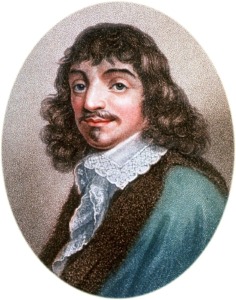
The dawn of the 17th century witnessed an intellectual revolution that would forever alter the landscape of Western philosophy, and at its epicenter stood René Descartes (1596-1650), a French mathematician, scientist, and philosopher whose radical approach to knowledge and reality earned him the enduring title “Father of Modern Philosophy.” This designation reflects not merely historical chronology but fundamental reorientation in how philosophers conceived their enterprise—from reliance on ancient authority and theological dogma to the primacy of human reason and systematic doubt. Descartes accomplished nothing less than setting the agenda for modern philosophical inquiry, establishing the mind-body problem as a central concern, developing the methodological skepticism that characterizes much of modern science, and bridging the previously separate domains of algebra and geometry through his revolutionary coordinate system.
The essence of Descartes’ revolution lies in his relentless pursuit of certainty in a world of intellectual upheaval. Living during the Scientific Revolution, which challenged Aristotelian physics and Ptolemaic cosmology, Descartes sought to reconstruct knowledge from its foundations using nothing but the undeniable truths discoverable by human reason. His famous declaration “cogito, ergo sum” (“I think, therefore I am”) became the epistemological cornerstone for modern thought, asserting the primacy of subjective consciousness as the starting point for philosophy. This essay will explore Descartes’ historical context, methodological innovations, metaphysical dualism, epistemological contributions, scientific achievements, and enduring legacy to understand why his thought represents such a decisive break from previous philosophical traditions and why it continues to influence contemporary debates in philosophy, cognitive science, and beyond.
To appreciate the revolutionary nature of Descartes’ philosophy, one must understand the intellectual milieu from which it emerged. The late Renaissance and early modern period in Europe was characterized by significant paradigm shifts across multiple domains of knowledge:
Descartes’ philosophical method emerged from his profound dissatisfaction with the Scholastic tradition that dominated European universities. He criticized Scholasticism for its reliance on sensory experience (which he deemed unreliable), its dependence on Aristotelian authority rather than reason, and its use of substantial forms and final causes in scientific explanations. In the Discourse on Method (1637), Descartes lamented that philosophical inquiry yielded “no one thing about which there is not some dispute, and thus nothing that is not doubtful.”
Descartes’ methodological doubt proceeds through several increasingly radical stages:
This comprehensive skepticism leads Descartes to the climactic realization that even if an evil genius deceives him about everything, he must exist to be deceived: “I think, therefore I am” (cogito, ergo sum). This first principle becomes the archimedean point upon which Descartes rebuilds knowledge. The cogito is significant not merely as a particular truth but as a model of certainty—it is known clearly and distinctly through direct intellectual apprehension rather than through fallible sensory experience.
In his earlier unpublished work, Rules for the Direction of the Mind (composed circa 1628 but published posthumously), Descartes outlined a more positive method for acquiring knowledge. He proposed four precepts that would enable reason to arrive at certain knowledge:
These rules reflect Descartes’ mathematical orientation, particularly his success in algebraic geometry. He believed that the methodical reasoning characteristic of mathematics could be extended to all domains of knowledge, including philosophy and science. This methodological universalism represents a key aspect of Descartes’ modernism—his conviction that human reason, properly directed, could achieve certain knowledge across all investigable domains.
From the cogito, Descartes deduced the essence of the thinking self: “I was a substance whose whole essence or nature is only to think.” This led to his famous mind-body dualism—the doctrine that reality consists of two fundamentally distinct kinds of substance:
This Cartesian dualism represented a radical departure from the Aristotelian-Scholastic hylomorphic view that soul and body form a unitary substance. It provided a metaphysical foundation for mechanistic physics, protected human freedom and immortality, and attempted to resolve epistemological problems by locating certainty in the thinking self.
After establishing his own existence and the distinction between mind and body, Descartes turned to proving God’s existence, which served crucial epistemological functions:
God’s veracity guarantees the reliability of clear and distinct perceptions, validating knowledge of the external world. Critics call this the Cartesian Circle.
Despite their substantial distinction, Descartes maintained that mind and body interact intimately:
Critics such as Princess Elisabeth questioned how an unextended mind could move an extended body. Descartes appealed to a primitive notion of mind-body union, but many found his solution unsatisfactory.
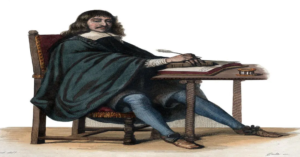
Descartes is classified as a rationalist, emphasizing reason rather than experience as the primary source of knowledge. Contrasted with empiricism (Locke, Hume), Cartesian rationalism includes:
However, Descartes’ practice also includes empirical methods, e.g., in optics, meteorology, and anatomy.
Descartes proposed clarity and distinctness as criteria for truth. Clear perceptions are present and accessible to the attentive mind, while distinct perceptions are precise and different from all other objects. God’s veracity underwrites the reliability of these criteria.
Descartes’ epistemology centers on the theory of ideas, which distinguishes:
He also distinguishes formal reality (existence as a mental state) from objective reality (representational content), critical for his proof of God’s existence.
Descartes developed analytic geometry, unifying algebra and geometry. Innovations include:
Descartes proposed a mechanistic philosophy of nature, rejecting final causes. He theorized:
In Treatise on Man, he described living organisms as machines, except humans, combining mechanical bodies with rational souls.
Descartes conducted anatomical dissections, optical experiments, and meteorological observations. He combined rational foundations with experimental verification.
Legacy of Descartes’ remains active in:
So René Descartes earns the title Father of Modern Philosophy through radical reorientation toward the knowing subject, methodological skepticism, dualistic metaphysics, and mathematical approach. While specific doctrines have been transformed.Then Cartesian framework continues to shape contemporary thought.
Here understanding Descartes illuminates the origins of modern thought, its methods, aspirations, and blind spots. His legacy endures in the ongoing pursuit of knowledge and the rational capacity encapsulated in “I think, therefore I am.”
Avicenna: Philosopher & Physician – The Polymath Who Healed Knowledge and Bodies
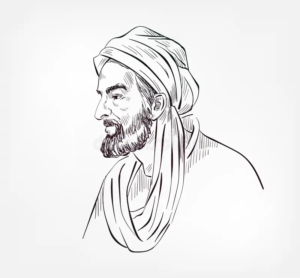
But what makes Avicenna trending today? In an age debating artificial intelligence, medical ethics, and the unity of science and spirituality, Avicenna’s integrative thinking provides a roadmap: science without philosophy is blind, philosophy without science is empty, and medicine without ethics is incomplete.
This blog takes you through Avicenna’s life, philosophy, medicine, and legacy, weaving in historical anecdotes and modern reflections, to show why his thought still matters—and why his name keeps resurfacing in global conversations.
Avicenna was born near Bukhara (modern Uzbekistan) in 980 CE. His father, a tax official, ensured his son had access to education. By age 10, the young boy had memorized the Qur’an and mastered classical Arabic—a feat that would foreshadow his lifelong devotion to learning.
As a teenager, he studied logic, geometry, astronomy, and metaphysics under local scholars, quickly surpassing them. By 16, Avicenna claimed to have fully grasped medicine, calling it “not difficult compared to mathematics and metaphysics.” Soon after, he began practicing as a physician—gaining fame not only for his skill in diagnosis but also for his gentle approach with patients.
At just 17 years old, Avicenna successfully treated the Samanid ruler Nuh ibn Mansur, earning access to the royal library in Bukhara. This was transformative: inside lay rare Greek, Indian, and Persian manuscripts, which Avicenna devoured. From this treasure trove, he forged the foundations of his encyclopedic knowledge.
Avicenna believed philosophy was not merely an abstract pursuit—it was a medicine for the soul. His works sought to unify Aristotle’s rationalism, Neoplatonism’s spirituality, and Islamic theology into a coherent system.
Despite its title, this was not a medical text. The Book of Healing (Kitāb al-Shifāʾ) was a sprawling encyclopedia covering logic, natural sciences, mathematics, psychology, and metaphysics. It aimed to “heal” ignorance by providing intellectual clarity.
Within it, Avicenna explored:
Avicenna’s most famous philosophical idea is the Flying Man thought experiment. He asked us to imagine a man created fully formed, floating in mid-air, blindfolded, with no sensory contact. Would he be aware of his own existence? Avicenna argued yes—the man would have an innate awareness of his soul, independent of the body.
This experiment anticipated later debates on consciousness, influencing both Islamic philosophers and European thinkers like Descartes. Today, neuroscientists and AI ethicists revisit the Flying Man as an early probe into the mystery of self-awareness.
Unlike some rationalists, Avicenna did not reject religion. He saw philosophy and faith as complementary: reason clarified divine truths, while revelation grounded human understanding in morality. His synthesis influenced Islamic theology, Christian Scholasticism, and even Jewish philosophy through figures like Maimonides.
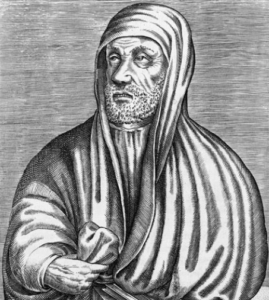
If Avicenna’s philosophy healed the soul, his medicine healed the body. His most enduring legacy in this realm is The Canon of Medicine (al-Qānūn fī al-ṭibb), completed around 1025.
This five-volume masterpiece systematized centuries of medical knowledge—from Hippocrates and Galen to Indian and Persian traditions. But Avicenna didn’t just compile; he critiqued, reorganized, and added original insights.
Key contributions include:
The Canon became the standard medical text in Europe for over 600 years, studied in universities like Montpellier and Padua until the 17th century.
Avicenna viewed health as a balance of body and soul. He described cases of melancholia (depression), recognizing psychological factors in illness. One famous anecdote tells of a prince suffering from lovesickness; Avicenna diagnosed the cause by observing changes in the young man’s pulse as different names were mentioned, eventually curing him through counseling.
In this way, Avicenna foreshadowed psychosomatic medicine and even modern psychiatry.
Though limited by the religious restrictions of his time, Avicenna’s anatomical descriptions were remarkably precise. He distinguished nerves from tendons, emphasized the importance of the spinal cord, and proposed surgical methods like nerve repair—ideas centuries ahead of his era.
Avicenna was fascinated by the cosmos. He theorized about the nature of stars, the Milky Way, and planetary motion. Some historians believe he may have observed the supernova of 1006, the brightest stellar event in recorded history.
In physics, he challenged Aristotelian mechanics, developing ideas resembling the modern concept of inertia. His notion that an object in motion remains in motion unless acted upon prefigured Newton’s first law.
Avicenna experimented with distillation, creating methods to extract essential oils from flowers. This not only influenced perfumery but also laid groundwork for chemistry and pharmacology.
Avicenna became a central figure in Islamic philosophy (falsafa). Schools of thought debated his ideas for centuries. Theologians like al-Ghazālī criticized him, while philosophers like Suhrawardī and Mullā Ṣadrā extended his insights.
Through Latin translations, Avicenna shaped European thought. His Canon of Medicine was a staple in medical schools, while his metaphysics influenced Thomas Aquinas, Albertus Magnus, and the entire Scholastic tradition.
– UNESCO’s Avicenna Prize for Ethics in Science (est. 2003) honors scientists advancing ethical reflection.
– A crater on the Moon and an asteroid bear his name.
– His works continue to be studied in philosophy, history of science, and medical ethics programs worldwide.
Why revisit Avicenna now? Because his life embodies principles we urgently need:
Avicenna’s genius was not just in mastering diverse fields, but in unifying them. For him, healing meant more than curing a fever or setting a bone—it meant restoring harmony between body, mind, and soul.
In a world fractured between science and spirituality, ethics and technology, East and West, Avicenna’s vision offers a powerful reminder: wisdom is not the possession of one culture but the shared inheritance of humanity.
The fact that his name trends over a thousand years after his death is not nostalgia—it’s relevance. Avicenna speaks to our time because he understood what makes us whole.
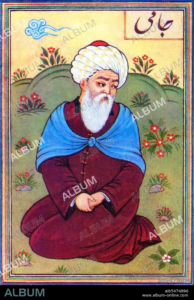
Few poets in world history have captured the imagination of humanity across cultures, faiths, and centuries as profoundly as Jalāl al-Dīn Muḥammad Rūmī (1207–1273). Known to the Persianate world as Mawlānā (“Our Master”) and to the West simply as Rumi, he was not only a poet but also a jurist, theologian, Sufi mystic, and spiritual teacher whose words continue to echo in mosques, monasteries, libraries, and living rooms worldwide. His writings, composed in Persian with inflections of Arabic, Turkish, and Greek, comprise some of the most celebrated works of Islamic mysticism: the Masnavi-ye Ma‘navi (Spiritual Couplets), often described as a “Persian Qur’an,” and the Divan-e Shams-e Tabrīzī, a vast compendium of ecstatic lyric poetry inspired by his beloved friend and guide, Shams.
To understand Rumi, however, one must situate him in his tumultuous historical moment — an era marked by Mongol invasions, shifting empires, and spiritual crosscurrents. His life was a journey from Balkh to Konya, from jurist to mystic, from scholar to poet of the heart. At its center stands the transformative force of divine love — a love that dissolved boundaries between faiths, cultures, and languages.
This biography presents a detailed exploration of Rumi’s life and legacy, moving through his upbringing, education, pivotal encounters, literary production, teachings, and enduring influence.
Rumi was born on 30 September 1207 in the city of Balkh, a major center of learning and culture in the Persianate world (present-day Afghanistan). His full name was Jalāl al-Dīn Muḥammad ibn Muḥammad ibn Ḥusayn al-Balkhī. The epithet Rumi (“from Rum”) was attached later, referencing Anatolia — called “Rum” by Muslims because it had been part of the Byzantine (Roman) Empire.
Rumi’s father, Bahāʾ al-Dīn Valad, was a renowned preacher, jurist, and mystic in Balkh, nicknamed Sultan al-ʿUlamāʾ (“Sultan of the Scholars”). His teachings blended Islamic jurisprudence with mystical reflection, laying a foundation for the young Jalāl al-Dīn’s dual identity as both scholar and seeker. His mother, believed to be of noble Khwarezmian descent, nurtured the household with refinement and devotion.
In Rumi’s youth, Central Asia was a cauldron of instability. The Mongol armies under Genghis Khan were sweeping westward, devastating cities such as Samarkand and Bukhara. Sensing the impending danger, Bahāʾ al-Dīn led his family on a long migration westward. They traveled through Nishapur — where the young Rumi is said to have met the poet ʿAttār — then Baghdad, Damascus, and Mecca on pilgrimage, before finally settling around 1228 in Konya, capital of the Seljuk Sultanate of Rum. It was here that Rumi would spend most of his life.
Rumi’s early education followed the classical curriculum of Islamic scholarship: Qur’anic studies, Hadith, Arabic grammar, Islamic jurisprudence, and theology. His father served as his first teacher. When Bahāʾ al-Dīn died in 1231, his followers and patrons looked to Jalāl al-Dīn to inherit his mantle. Though still young, Rumi assumed leadership and became the head of a madrasah in Konya, teaching law, issuing legal opinions, and delivering sermons.
Rumi was not only a jurist but also a theologian well-versed in the intellectual currents of his time. He pursued further training in Aleppo and Damascus, two centers of advanced Islamic learning. In Damascus, he encountered leading scholars and Sufi teachers, refining his mastery of both exoteric knowledge and esoteric wisdom. By the 1240s, Rumi was widely respected in Konya as a sober and learned scholar. Yet beneath this respectable exterior stirred a yearning for a deeper, more direct experience of divine reality — a yearning that would find its answer in the figure of Shams al-Dīn of Tabriz.
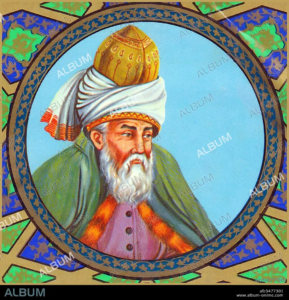
The pivotal moment in Rumi’s life occurred in November 1244, when he met Shams al-Dīn Tabrīzī, a wandering dervish of fiery temperament and uncompromising spirituality. Shams was eccentric, unconventional, and utterly devoted to the quest for God. The two men formed an intense spiritual companionship. Rumi abandoned much of his teaching and juristic duties, spending long hours in secluded dialogue with Shams. He described Shams not merely as a friend but as a mirror of the Divine Beloved. Their conversations sparked in Rumi a torrent of mystical experience, which poured forth in ecstatic verse.
This radical shift alarmed many of Rumi’s students and family, who resented Shams’ influence. After only a year, Shams disappeared — possibly fleeing hostility, possibly murdered by jealous disciples in 1247 or 1248. His disappearance devastated Rumi. Yet from that grief emerged one of the most extraordinary literary transformations in history: Rumi turned his longing for Shams into poetry that voiced the soul’s longing for God.
In memory of Shams, Rumi composed a vast collection of lyric poetry — ghazals, qasidas, and quatrains totaling more than 40,000 lines. Known as the Divan-e Shams-e Tabrīzī, the work is not merely a personal elegy but a monumental celebration of mystical love. In these poems, Shams is both the human friend and the symbol of the Divine. The imagery is ecstatic — wine, music, dance, fire, and union all serve as metaphors for the annihilation of the self in God.
Between 1260 and 1273, Rumi dictated his magnum opus, the Masnavi, to his disciple Husam al-Din Chelebi. Comprising six books and about 25,000 couplets, the Masnavi blends parables, anecdotes, Qur’anic exegesis, and mystical allegories. It is at once a spiritual commentary on the Qur’an and a practical manual for seekers on the Sufi path. The text covers themes of divine love, self-purification, humility, and union with the Beloved, and for centuries has been studied as “the Persian Qur’an.”
This prose work compiles Rumi’s discourses given to his disciples. Less ornamented than the poetry, Fihi Ma Fihi provides direct insight into his thought: reflections on metaphysics, the role of the spiritual master, the nature of the soul, and the ultimate reality of God.
Rumi also left behind letters to nobles, disciples, and family members. These reveal his role as a community leader, mediator, and spiritual guide. They show that while his poetry soared to mystical heights, he remained engaged in the practical affairs of Konya.
At the heart of Rumi’s thought is love (ʿishq). Love is the force that moves the universe, the bridge between human and divine, the energy that transforms pain into beauty. For Rumi, every form of love — for a teacher, a friend, or humanity — is a reflection of the Divine Love that sustains existence.
Rumi’s poetry constantly circles around the paradox of separation and union. The soul, exiled from its source, longs for reunion with God, like the reed flute that laments its separation from the reed bed. This longing, while painful, is also the engine of spiritual growth.
Wine, taverns, music, dance, and intoxication serve as metaphors for spiritual ecstasy. Fire represents both destruction of the ego and illumination of the soul. The lover–beloved imagery expresses the relationship between human and Divine. These symbols allow Rumi to communicate experiences beyond the reach of discursive theology.
While often celebrated today as a universal mystic, Rumi was deeply rooted in Islam. The Qur’an and Hadith permeate his works, and he consistently framed his mystical vision within Islamic concepts of tawḥīd (Divine unity), prophecy, and ethical living. The Masnavi was considered by his contemporaries a continuation of Islamic spiritual commentary.
After Shams’ disappearance, Rumi deepened his role as a teacher and spiritual guide. With Husam al-Din Chelebi and later his son Sultan Walad, he gathered a community of disciples that would crystallize into the Mevlevi Order, known for its whirling dance (sema) symbolizing the soul’s ascent toward God.
Rumi’s gatherings in Konya were remarkable for their inclusivity. Muslims, Christians, and Jews attended his sermons, drawn by his universal language of love. His school combined scholarship with spiritual practice, making Konya a beacon of learning and devotion.
Rumi passed away on 17 December 1273 in Konya. His funeral drew a vast crowd of Muslims, Christians, Jews, and others, each group claiming him as their own. His mausoleum, the Green Dome (Kubbe-i Hadra), remains a major pilgrimage site in Konya, now part of the Mevlana Museum.
After his death, his followers formalized his teachings into the Mevlevi Sufi order. The “whirling dervishes” became a distinctive expression of his mystical heritage, combining poetry, music, and dance as spiritual practice. His son, Sultan Walad, composed works preserving his father’s legacy and institutionalizing the order.
Over the centuries, Rumi’s influence has only grown. In the Persianate world, he shaped the mystical literature of Iran, Turkey, Central Asia, and the Indian subcontinent. Figures like Hafez, Jami, and Iqbal drew inspiration from him. In Ottoman Turkey, the Mevlevis became patrons of art, music, and literature.
In the modern West, translations — especially those by Coleman Barks — have popularized Rumi as a best‑selling poet, though often stripped of explicit Islamic context. This has sparked debate: some celebrate his universal accessibility, while others stress the importance of recognizing his Islamic and Sufi roots. Nevertheless, Rumi speaks across divides. His words on love, longing, humility, and unity resonate with secular seekers and religious devotees alike. He stands as a bridge between East and West, faith and reason, mysticism and poetry.
Rumi’s life was a journey of transformation: from jurist to mystic, from scholar to poet, from Balkh to Konya, from the grief of loss to the ecstasy of divine love. His writings remain among the most profound expressions of the human soul’s search for God. At the core of his message is a simple yet inexhaustible truth: Love is the essence of all existence. Today, more than 800 years after his death, Rumi continues to invite us to enter the circle of love, to whirl with the dervishes, to listen to the flute’s lament, and to remember the Beloved.
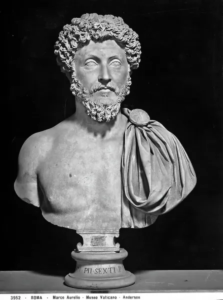
The Roman Empire had many leaders, but Marcus Aurelius stands out. He was a philosopher-king who lived by Stoic principles.
Marcus Aurelius, a Stoic Emperor, ruled the Roman Empire with wisdom. He left behind a wealth of philosophical thoughts in his writings.
His time in power is a great lesson in leadership and philosophy. It shows us how to face life’s challenges.
Marcus Aurelius was born on April 26, 121 AD. He came from a noble Roman family. His upbringing was a mix of luxury and hard study, common for the aristocracy.
His father, Marcus Annius Verus, was rich and influential. His mother’s family, the Calvisii, was also well-respected. This made Marcus‘s start in life very promising.
Marcus grew up with the power and duties of nobility around him. He was taught both books and fighting, preparing him for leadership.
His childhood taught him about duty, honor, and learning. These lessons shaped his later love for Stoicism.
Marcus Aurelius‘s education was key in shaping his thoughts and leadership. He learned from many tutors, each influencing his views and actions.
Marcus Aurelius had several important tutors. Marcus Cornelius Fronto, a famous orator and lawyer, taught him about rhetoric and hard work. Fronto’s lessons on diligence and integrity deeply affected Marcus Aurelius.
Junius Rusticus introduced Marcus Aurelius to Stoicism through Epictetus’s works. This exposure deeply influenced Marcus Aurelius, shaping his Stoic beliefs and leadership approach.
Marcus Aurelius was also exposed to other philosophies. His education was diverse, covering many perspectives. This broadened his understanding of the world.
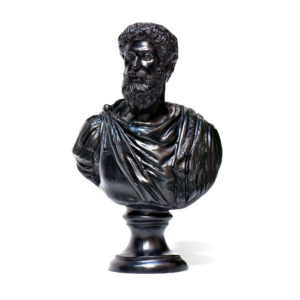
Marcus Aurelius‘s adoption by Antoninus Pius in 138 AD was a key moment. It started his journey to become emperor.
Antoninus Pius, chosen by Emperor Hadrian, adopted Marcus Aurelius and his brother Lucius Verus. This move was strategic. It ensured Marcus Aurelius‘s future role.
Under Antoninus Pius, Marcus Aurelius learned politics, philosophy, and military affairs. He was prepared for leadership, taking on roles in the Roman administration.
Marcus Aurelius‘s time under Antoninus Pius was very valuable. He learned by attending senate meetings and making important decisions. This training helped him face the challenges of being emperor.
The year 161 AD was a turning point for Marcus Aurelius as he took the throne with Lucius Verus. This started a new chapter for the Roman Empire, with Marcus Aurelius leading the way.
Marcus Aurelius became emperor after Antoninus Pius adopted him. This was a common practice in Rome to ensure a smooth transition. It showed the empire’s commitment to stability and continuity.
Marcus Aurelius chose to rule alongside Lucius Verus, whom he also adopted. This was a bold move, aiming to strengthen the empire’s leadership. Yet, it brought its own set of challenges due to their different personalities and governance styles.
Marcus Aurelius faced many challenges early in his reign. The empire was threatened by neighboring tribes and needed to stay prosperous and stable internally.
| Challenge | Description | Outcome |
|---|---|---|
| External Pressures | Threats from neighboring tribes | Successful defense and strategic alliances |
| Internal Issues | Administrative and economic challenges | Reforms and adjustments to governance |
Marcus Aurelius tackled these challenges with his usual stoic strength. His early years as emperor showed his ability to balance leadership with his deep commitment to Stoic philosophy.
Marcus Aurelius brought many reforms to his rule, showing his Stoic values. He aimed for justice, fairness, and the happiness of his people.
He made laws simpler and fair for everyone. He also helped the poor and supported education.
He worked hard to keep the economy stable. He invested in projects to grow the economy.
His Stoic beliefs shaped how he ruled. He sought to be just and wise in his decisions.
| Reform Area | Description | Impact |
|---|---|---|
| Legal Reforms | Simplified legal procedures, equal application of law | Improved justice system |
| Social Policies | Aid to the poor, promotion of education | Enhanced social welfare |
| Economic Management | Currency stabilization, infrastructure investment | Economic growth and stability |
Marcus, a Stoic emperor, faced many challenges during his reign. He dealt with wars and plagues that hit the Roman Empire hard. His leadership and beliefs were tested by these significant military battles.
The Parthian War started in 161 AD. It was sparked by a Parthian invasion of Armenia, a Roman ally. Marcus Aurelius sent troops, led by co-emperor Lucius Verus, to the area.
The Marcomannic Wars lasted from 166 to 180 AD. Germanic tribes, like the Marcomanni and Quadi, threatened the empire’s safety. Marcus Aurelius led the Roman forces, using his Stoic beliefs to cope with war’s hardships.
The Antonine Plague hit during Marcus Aurelius‘s rule. It greatly reduced the Roman population, affecting the military and economy.
The wars and plague weakened the Roman Empire. The loss of people and economic troubles had lasting effects on the empire’s stability.
Marcus Aurelius‘s response to these crises is seen in his Meditations. He emphasized the need for resilience and inner strength. His Stoic philosophy guided him as a leader.
| Crisis | Impact | Marcus Aurelius’s Response |
|---|---|---|
| Parthian War | Strained military resources | Led by example, supported Lucius Verus |
| Marcomannic Wars | Threatened Danube frontier | Personally led campaigns, applied Stoic resilience |
| Antonine Plague | Significant population loss, economic disruption | Reflected on impermanence of life in Meditations |
Marcus Aurelius‘s life was a mix of duty, family, and deep thinking. As a Stoic Emperor, he ruled the Roman Empire while staying true to his beliefs.
Marcus Aurelius married Annia Galeria Faustina, known as Faustina the Younger. Their marriage was arranged, common among the Roman elite. Yet, they had a lasting bond until Faustina’s passing. Faustina was admired for her beauty and strength, and they had many children together.
They had at least 13 kids, but only a few grew up. Their children included Commodus, who became emperor after Marcus Aurelius. Family was key to Marcus Aurelius‘s life, balancing family with his duties was tough.
He followed Stoic philosophy in all he did, as a ruler and family man.
Some of his habits were:
These habits showed his strong character and values.
Marcus Aurelius‘s “Meditations” is a key part of Stoic philosophy. It gives us a look into the mind of a Roman emperor. This collection of personal thoughts and prayers shows how Stoic ideas can guide leadership and everyday life.
“Meditations” was written by Marcus during his military campaigns, from 170-180 AD. It was meant for his own guidance, not for the public. It shows the emperor’s dedication to Stoicism and his efforts to live by its principles.
The “Meditations” is divided into 12 books, each covering different Stoic topics. The entries are short and to the point, focusing on virtue, morality, and the universe. It’s a deeply personal work, showing the emperor’s inner struggles and his search for wisdom.
The “Meditations” explores important Stoic ideas like virtue, morality, nature, and cosmic order. These themes are woven throughout, giving a full picture of Stoic thought.
| Concept | Description | Significance |
|---|---|---|
| Virtue | Living in accordance with reason and nature | Guides moral character and actions |
| Morality | Principles guiding human behavior | Essential for personal and societal harmony |
| Nature | The natural world and its order | Provides a framework for understanding the universe |
| Cosmic Order | The rational structure of the universe | Underlies the Stoic view of reality |
In conclusion, “Meditations” by Aurelius is a treasure trove of Stoic philosophy. It offers insights into a leader who tried to live by Stoic principles. Through its exploration of virtue, morality, nature, and cosmic order, it continues to inspire and guide those seeking wisdom and a deeper understanding of life.
Marcus was a philosopher-emperor who lived by Stoicism. He used its teachings to lead his empire. His life shows how valuable Stoic philosophy is for leaders and individuals.
Stoicism believes in reason, self-control, and not caring about things outside of our control. Marcus followed these ideas. He focused on what he could control, like his reactions, not external events.
The philosophy also teaches living in harmony with nature and accepting things we can’t change. This helped Marcus stay calm during tough times, like wars and plagues.
Marcus was a just
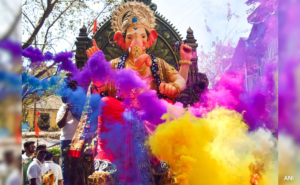
Every year, as the monsoon clouds begin to part over India, streets and homes burst into color, chants of Ganapati Bappa Morya echo through neighborhoods, and the scent of incense mingles with fresh modaks. This is the season of Ganesh Utsav, a celebration of Lord Ganesha, the elephant-headed deity revered as the remover of obstacles, the harbinger of wisdom, and the patron of arts and sciences.
But Ganesh Utsav is not merely a festival. It is a multi-layered cultural phenomenon—a blend of myth, devotion, politics, community, art, and even environmental consciousness. From its ancient Vedic roots to its reinvention during India’s freedom struggle, and from intimate household rituals to massive global processions, the festival reveals how faith and tradition continuously adapt to changing times.
This blog dives deep into the history, symbolism, rituals, controversies, and modern transformations of Ganesh Utsav, while also reflecting on its timeless relevance in a fast-paced globalized world.
The story of Ganesha’s creation is as fascinating as his form. According to the Shiva Purana, Goddess Parvati fashioned him from turmeric paste as a guardian for her chambers. When Lord Shiva returned and found the boy blocking his entry, a furious battle ensued, ending with Shiva severing Ganesha’s head. To console Parvati’s grief, Shiva replaced it with an elephant’s head, granting the boy immortality as the foremost deity of worship.
This myth is layered with symbolism—Ganesha’s head signifies wisdom, his large ears receptivity, his broken tusk sacrifice, and his potbelly the universe itself. Unlike many deities, Ganesha transcends sectarian boundaries and is worshiped across Shaivism, Vaishnavism, Shaktism, Jainism, and even Buddhism.
The earliest known references to Ganesha date back to the Gupta period (4th–6th century CE), when he emerged as a distinct deity. Archeological evidence of Ganesha idols has been found across India, Nepal, Cambodia, and Indonesia, revealing how Indian culture spread through trade and pilgrimage.
By the medieval period, Ganesha became the “Vighnaharta” (remover of obstacles), invoked at the beginning of rituals, journeys, and new ventures—an enduring practice that survives in homes and businesses today.
Ganesh Chaturthi, marking Ganesha’s birthday, was historically celebrated in private households. Families would craft clay idols, perform puja, and immerse the deity in water after the rituals.
The festival underwent a radical transformation in 1893, when freedom fighter Lokmanya Bal Gangadhar Tilak turned Ganesh Utsav into a public celebration. At a time when the British banned political gatherings, Tilak cleverly used the religious festival as a platform to foster unity, nationalism, and social reform.
Large pandals (temporary shrines) sprang up across Maharashtra, where people gathered for prayers, debates, plays, and patriotic songs. What began as devotion became a tool of resistance and empowerment—a reminder that festivals are not just rituals, but catalysts of social change.
The festival begins with the installation of clay idols of Ganesha in homes and pandals. The ritual of pranapratishtha—infusing divine life into the idol—is performed by priests chanting Vedic mantras.
The deity is offered 21 durva grass blades, 21 modaks, red hibiscus flowers, coconut, and jaggery. Each offering carries symbolic meaning—modaks as rewards of wisdom, grass as humility, and hibiscus as energy.
Morning and evening aartis (devotional songs) are performed with drums, bells, and chants. In public pandals, cultural programs, bhajan sessions, yoga camps, and even blood donation drives take place—blending spirituality with social service.
The final day, Anant Chaturdashi, witnesses massive processions carrying the idol for immersion (visarjan) in rivers, lakes, or seas. The immersion symbolizes the cycle of creation and dissolution, teaching detachment and renewal.
Ganesh Utsav fuels artistic creativity—giant pandals with elaborate themes, from mythology to modern issues like climate change. Traditional instruments like dhol-tasha electrify processions, while devotional songs like Sukhkarta Dukhaharta echo across gatherings.
The festival is incomplete without modaks, considered Ganesha’s favorite sweet. Each region adds its twist—fried modaks in Maharashtra, steamed kozhukattai in Tamil Nadu, or coconut-stuffed ukadiche modak. The food signifies gratitude and community sharing.
Every part of Ganesha’s form teaches a lesson:
The idol itself is a philosophical text in form—a reminder that spirituality is embedded in everyday life.
The grandeur of Ganesh Utsav has raised serious environmental issues: plaster of Paris idols, chemical paints, and plastic decorations pollute rivers and harm marine life.
In response, many communities are embracing:
This shift reflects how festivals evolve with contemporary concerns, proving spirituality and ecology can go hand in hand.
Despite its popularity, Ganesh Utsav is not without debates:
These debates highlight the tension between tradition and modernity, faith and commercialization.
Today, Ganesh Utsav has transcended borders. In places like London, Toronto, and Sydney, immigrant communities recreate the festival, inviting locals to join in. The deity of beginnings has become an ambassador of Indian soft power, spreading cultural diplomacy across continents.
Interestingly, Ganesha has also entered pop culture—appearing in yoga studios, tattoos, contemporary art, and even business boardrooms as a symbol of prosperity and success.
Psychologists note that festivals like Ganesh Utsav fulfill deep human needs for community, identity, and renewal. The rituals provide structure, the chants create collective energy, and the immersion ritual teaches detachment.
Sociologically, Ganesh Utsav acts as a social glue—cutting across caste, class, and even religious boundaries in many places. It exemplifies how shared traditions strengthen social cohesion in times of rapid change.
Ganesh Utsav is not just about tradition but about timeless lessons for modern life:
From a household ritual in ancient India to a nationalist movement under Tilak, and from community pandals in Mumbai to eco-conscious celebrations worldwide, Ganesh Utsav has continually reinvented itself while retaining its spiritual essence.
At its heart, the festival celebrates not only the deity but also the human capacity to unite, create, and transform. It is a reminder that true devotion lies not just in rituals but in embodying Ganesha’s qualities—wisdom, humility, adaptability, and compassion.
As the chants fade and the idols dissolve into rivers, what remains is the festival’s deeper message: every ending is a new beginning. In a world of constant uncertainty, Ganesh Utsav continues to teach us resilience, renewal, and the power of collective spirit.
Ganapati Bappa Morya!